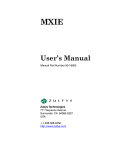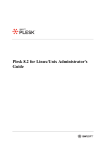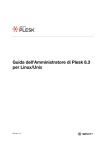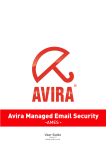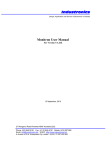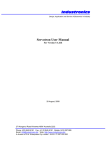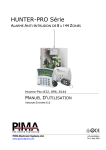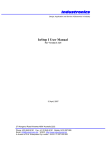Download AVIRA MANAGED EMAIL SECURITY User guide
Transcript
Avira Managed Email Security (AMES) User Guide Table of Contents Table of Contents 1. Product information ................................................................. 4 1.1 Functionality . . . . . . . . . . . . . . . . . . . . . . . . . . . . . . . . . . . . . . . . . . . . . . . . . . . . . . . . . . . . . . . .4 1.2 Licensing AMES . . . . . . . . . . . . . . . . . . . . . . . . . . . . . . . . . . . . . . . . . . . . . . . . . . . . . . . . . . . . .5 2. Getting started with AMES ........................................................ 6 2.1 Adding a new domain to AMES . . . . . . . . . . . . . . . . . . . . . . . . . . . . . . . . . . . . . . . . . . . . . . . .6 2.2 Logging in to AMES . . . . . . . . . . . . . . . . . . . . . . . . . . . . . . . . . . . . . . . . . . . . . . . . . . . . . . . . . .6 2.3 Configuring the AMES domain . . . . . . . . . . . . . . . . . . . . . . . . . . . . . . . . . . . . . . . . . . . . . . . .7 2.4 Scanning outgoing emails . . . . . . . . . . . . . . . . . . . . . . . . . . . . . . . . . . . . . . . . . . . . . . . . . . . .9 3. Setting your AMES domains and users ........................................ 10 3.1 Making general domain settings . . . . . . . . . . . . . . . . . . . . . . . . . . . . . . . . . . . . . . . . . . . . . 10 3.2 Setting the services available to end-users . . . . . . . . . . . . . . . . . . . . . . . . . . . . . . . . . . . 11 3.3 Adding new users to a domain . . . . . . . . . . . . . . . . . . . . . . . . . . . . . . . . . . . . . . . . . . . . . . 12 3.3.1 Adding a new user . . . . . . . . . . . . . . . . . . . . . . . . . . . . . . . . . . . . . . . . . . . . . . . . . . . . . . . . 12 3.3.2 Adding multiple users to a domain (Mass Add) . . . . . . . . . . . . . . . . . . . . . . . . . . . . . . . 14 3.4 Import/ Export the list of domain users . . . . . . . . . . . . . . . . . . . . . . . . . . . . . . . . . . . . . . 15 3.5 Adding a user alias . . . . . . . . . . . . . . . . . . . . . . . . . . . . . . . . . . . . . . . . . . . . . . . . . . . . . . . . . 16 3.6 Resetting user passwords . . . . . . . . . . . . . . . . . . . . . . . . . . . . . . . . . . . . . . . . . . . . . . . . . . . 17 3.7 Synchronization settings (LDAP/ CSV) . . . . . . . . . . . . . . . . . . . . . . . . . . . . . . . . . . . . . . . 18 3.8 Domain queue information . . . . . . . . . . . . . . . . . . . . . . . . . . . . . . . . . . . . . . . . . . . . . . . . . 18 3.9 Changing the email delivery options for a user . . . . . . . . . . . . . . . . . . . . . . . . . . . . . . . . 18 3.10 Customizing email signatures . . . . . . . . . . . . . . . . . . . . . . . . . . . . . . . . . . . . . . . . . . . . . . 19 3.11 Setting up an automatic reply . . . . . . . . . . . . . . . . . . . . . . . . . . . . . . . . . . . . . . . . . . . . . . 21 4. Quarantine Management ........................................................ 22 4.1 Configuring the email filters . . . . . . . . . . . . . . . . . . . . . . . . . . . . . . . . . . . . . . . . . . . . . . . . 22 4.1.1 Handling intercepted spam or viruses . . . . . . . . . . . . . . . . . . . . . . . . . . . . . . . . . . . . . . . 22 4.1.2 Adjusting the filter settings . . . . . . . . . . . . . . . . . . . . . . . . . . . . . . . . . . . . . . . . . . . . . . . . 24 4.2 Setting up virus and spam notifications . . . . . . . . . . . . . . . . . . . . . . . . . . . . . . . . . . . . . . 27 4.3 Managing the quarantines directly from your email account . . . . . . . . . . . . . . . . . . . 29 4.4 Managing the quarantines from your AMES account . . . . . . . . . . . . . . . . . . . . . . . . . . . 31 AMES User Guide (Status: 24 Jan 2012) 2 Table of Contents 5. User management .................................................................. 34 5.1 User management in advanced mode . . . . . . . . . . . . . . . . . . . . . . . . . . . . . . . . . . . . . . . . 35 6. Statistics .............................................................................. 39 7. Support ................................................................................ 42 AMES User Guide (Status: 24 Jan 2012) 3 Product information 1. Product information Thank you for taking a look at the Avira Managed Email Security (AMES) manual. This manual will help you get started with AMES, as well as customizing AMES to your specific needs. You will have peace in your inbox in no time. 1.1 Functionality Avira Managed Email Security (AMES) is a service dedicated to stopping spam or viruses before they reach your company’s network. This is achieved by routing the emails to our AMES server cluster. AMES then scans and delivers the malware-free emails to your server. The most accurate spam scanning technology For intercepting spam, we use a combination of technologies proven to be extremely effective. Since spammers and virus makers become more skilled every day, we constantly test and implement new methods to keep our lead position in email scanning, and you enjoy the benefits of this without any extra effort. Configuring AMES Because we stop spam and viruses "in the cloud", that is also the place where the configuration is done. You can log in to the AMES interface at https://ames.avira.com. Currently, the AMES interface is available in the following languages: • English • German • French • Spanish • Dutch AMES saves your language preference in a cookie or tries to match your browser’s language. In case of an unsupported language, the AMES interface opens in English. AMES User Guide (Status: 24 Jan 2012) 4 Product information Release notes To keep you up to date with the latest developments, we placed a link to the Release notes page (available at Partner and domain administrator levels only). 1.2 Licensing AMES When you let your Avira Partner purchase a license for AMES, you need to choose the number of users. These users correspond to the total number of people in your organization, that are going to use AMES to filter emails. AMES gives you total freedom to distribute these users across multiple domains, create aliases for them, set filtering rules, etc. but you should always keep your license up to date with the actual users. For more information, see the AMES terms and conditions on our website. AMES User Guide (Status: 24 Jan 2012) 5 Getting started with AMES 2. Getting started with AMES You'll find that once your Avira Partner has set up a license for your domain, the rest of the configuration is surprisingly easy. If you don't have an Avira Partner yet, please take a look at the Avira Partner Locator on our website. 2.1 Adding a new domain to AMES To add a new domain to AMES, please call your Avira Partner. They will then register your details, request a license and add the domain to AMES. 2.2 Logging in to AMES The domain is created in AMES and you will receive an order confirmation email with the credentials for the AMES account and details such as DNS MX settings and Firewall settings. 1. Open https://ames.avira.com in your browser, where you'll find the login screen: 2. Fill in your Login name, the Domain you want to access, and your Password. These were written in the order confirmation your partner received. 3. Click Login. You will see the AMES Service License Agreement (SLA), which you need to read and agree, to continue. AMES User Guide (Status: 24 Jan 2012) 6 Getting started with AMES 2.3 Configuring the AMES domain For each new domain, one generic user is created (see "The catch-all user" - page 12) and the mail delivery is set to the currently used mail server. This means, you can start using AMES without any further configuration and the email flow will not be interrupted. Normally, your partner carries out the domain configuration for you, but if for some reason you need to do this yourself, we'll guide you in the process. The Domain status assistant After logging in to AMES, click the Services tab in the Domain overview. The Domain status link opens the 5-step domain activation assistant, which shows the status of each step and eventually displays instructions to complete them: 1. Domain validation 2. Mail server delivery 3. DNS settings AMES User Guide (Status: 24 Jan 2012) 7 Getting started with AMES 4. Firewall settings 5. User configuration Configuring the DNS server To activate the scanning and filtering of incoming emails, you have to change the MXsettings in the DNS server for the domain. The correct records are in the order confirmation email. If correct, the MX records are displayed in green under Domain DNS information in the Services tab of the Domain overview.In case the MX records are not correctly set, a message in red is displayed. For example: Note Make sure there is no MX-record with a priority below 10; otherwise emails from your organization will not be scanned and filtered by AMES. Depending on the Time-To-Live (TTL) settings of your MX records, it might take up to 24 hours before DNS changes become active. AMES User Guide (Status: 24 Jan 2012) 8 Getting started with AMES After directing the MX records to the Avira AMES cluster, the managed service is active and will scan and filter the incoming emails. The filtered and scanned emails will be delivered to the regular mailbox. Configuring security and firewall After DNS changes are complete and propagated correctly, make sure the receiving mail server accepts only emails coming from the AMES server cluster mentioned in the order confirmation email. This can be done through settings in the firewall or mail server itself. 2.4 Scanning outgoing emails By default, AMES scans only the incoming emails. The relay service (scanning of outgoing emails) is initially deactivated. If you want AMES to scan your outgoing emails for viruses, please contact your Avira partner, to activate the relay feature for your domain. With enabled relay service, the domain’s administrators will see the amount of filtered outgoing messages. A daily maximum amount of messages is set, depending on the number of users: the amount of users in the domain, multiplied by 50 (never less than 1000 messages). If this limit is reached, the administrators receive a bounce message. AMES User Guide (Status: 24 Jan 2012) 9 Setting your AMES domains and users 3. Setting your AMES domains and users 3.1 Making general domain settings First, you should check the general settings of the new domain. 1. In the Domain overview, click the Domain tab. The Domain status link opens the 5-step domain activation assistant (see "The Domain status assistant" - page 7). 2. Your partner can activate or deactivate your domain. The license type and the maximum number of users for the domain are displayed under Domain settings. 3. In the Email domain administrator field, type the email address of the domain administrator. 4. Insert the Default incoming SMTP server(s), which will apply to the new users you create. Add only one IP address or hostname on each line. If you want to assign these servers to all domain users, use the "Click here" link. 5. In case you want to block the email accounts of certain users, but keep their quarantines for a while, add their email addresses in the Blocked recipients field. AMES User Guide (Status: 24 Jan 2012) 10 Setting your AMES domains and users When released from quarantine, blocked emails can be released as attachment or as the original message. To set this behavior for the entire domain, use the option Type of quarantine release: • Release as the original message - Send the original message to the users’ inboxes. • Release as an attachment - Send the blocked message as attachment to a warning email to the users’ inboxes. 3.2 Setting the services available to end-users 1. In the Domain overview, click the Services tab. 2. Under Services available to users, you can enable or disable certain options for all the end-users of the selected domain. • Sender domain MUST exist - If the domain of the sender does not resolve, the message is considered spam. • SMTP Deliver - Messages are delivered to the SMTP mail server. • Mail forward - Messages are forwarded to another email address. • VirusScan - Messages are scanned for viruses. • SpamFilter - Messages are scanned for spam. • ContentFilter - Message components are scanned, according to the whitelist/ blacklist content rules. • Auto-reply - The users are allowed to activate the auto-reply service. • Users are allowed to change their own settings - The users can activate virus notifications and schedule quarantine reports. AMES User Guide (Status: 24 Jan 2012) 11 Setting your AMES domains and users 3.3 Adding new users to a domain When AMES is configured for your domain, the users you provide have to operate properly. If an email is sent to the email address [email protected], the user test has to exist, or the email will bounce back to the sender. The catch-all user By default, AMES has one catch-all user. A catch-all user is convenient because it receives emails for all users on your domain. Note Avira discourages the use of a "catch-all" setting. The best approach is to create a separate user account in AMES for every user you have. The LDAP feature can reduce the time spent on this task. Please contact your Avira partner for more information. 3.3.1 Adding a new user 1. To add a new user manually, go to the Domain overview and click the Users tab. 2. Click Add user to open the Add user to domain dialog: Each User name is considered to be the primary email address of that user; any other email address of that specific user is considered an alias. AMES User Guide (Status: 24 Jan 2012) 12 Setting your AMES domains and users 3. Type the User name and Password for your new user. The password has to be minimum 6 characters long. The password strength is shown as you type: 4. If you'd like this user to be able to manage the domain’s settings on https://ames.avira.com, enable the Domain admin option. 5. You can apply the settings from an existing user, by selecting it from the drop-down list Copy settings from. 6. When finished, click Save. You will be warned that the user is disabled by default. This is done so you can review the settings before they take effect. 7. To enable the user, click its name in the Users tab and activate the status option and the available services in the Services tab: • VirusScan - Messages are scanned for viruses. • SpamFilter - Messages are scanned for spam. AMES User Guide (Status: 24 Jan 2012) 13 Setting your AMES domains and users • ContentFilter - Message components are scanned, according to the whitelist/ blacklist content rules. • Auto-reply - The users are allowed to activate the auto-reply service. • SMTP Deliver - Messages are delivered to the SMTP mail server. • Mail forward - Messages are forwarded to another email address. 3.3.2 Adding multiple users to a domain (Mass Add) 1. To add multiple users at once, go to the Domain overview, click the Users tab and press Mass Add. 2. Insert the names of the new users, one per line, in the User names area. 3. You can apply the settings from an existing user, by selecting it from the drop-down list Copy settings from. 4. The Mass Add feature generates random passwords and sends them by email to the users, if the option Send mail to users is set to yes. 5. When finished, click Save. A message is displayed, with the list of users and passwords added to the domain. 6. Send the new credentials to your new users, if the option Send mail to users was set to no. AMES User Guide (Status: 24 Jan 2012) 14 Setting your AMES domains and users 3.4 Import/ Export the list of domain users Avira-Partners and AMES domain administrators can import/ export the list of the users of a domain in a csv-type file. The file is editable and contains the settings for each user. It can be used to easily add or modify the settings for a large number of users (mass updates). 1. To carry out an import or export of the users’ list, go to the Domain overview, click the Domain tab and scroll down to the CSV Import/Export section. 2. Click Export CSV and open the export file in an editor or save it on your system. You can make changes to the users’ settings in a spreadsheet, as needed. 3. Then you can save the file as .txt and import it into the domain again, by clicking Import CSV on the Domain tab. 4. In the Import File dialog, select the file from your system and click Upload. 5. You can review the list of imported users and click sync, to finalize the import and generate new random passwords for all the users. Status symbols: - added user AMES User Guide (Status: 24 Jan 2012) 15 Setting your AMES domains and users - modified user - deleted user 3.5 Adding a user alias User aliases can be used to assign multiple email addresses to one user. 1. If you'd like to create an alias, select the user from the Users tab. The Services tab for the selected user opens: 2. Add one or more email addresses in the Email aliases field (e.g. [email protected]). Insert each of them on a new line, not separated by other characters. 3. Click Save on the bottom of the page when done. AMES User Guide (Status: 24 Jan 2012) 16 Setting your AMES domains and users Greylisting Warning If you'd like to use a catch-all address, use the * placeholder (*@domain.demo), but please note: The use of a so-called catch-all setting, where every combination of characters in front of the domain name is accepted as an email address (*@example.com), makes your domain extra vulnerable to spam and viruses. This is why AMES enables advanced greylisting for all catch-all users. This technique bounces emails from unknown senders the first time, and will accept only the second or later attempt. Because a lot of spam servers will not try to resend emails, greylisting significantly reduces the amount of emails that must be filtered and scanned. Note Since the time it takes for the emails to be re-delivered depends on the sender's mail server, thus delaying the email delivery, Avira discourages the use of a "catch-all" setting. The best approach is to create a separate user account in AMES for every user you have. The Domain synchronization feature can really cut the time spent on this task. 3.6 Resetting user passwords Domain administrators and Avira partners can reset the passwords of all users of a domain, by generating random passwords. 1. To reset all user passwords within a domain, go to the Domain overview, click the Services tab and scroll down to the Password reset section. 2. Leave the option Send mail to users enabled (yes, default setting), if you want to send the new credentials to the users by email. 3. Click Reset passwords, to generate the new credentials. A list of the generated data is displayed. AMES User Guide (Status: 24 Jan 2012) 17 Setting your AMES domains and users 4. If you did not enable the option Send mail to users, make sure you save this list and send the credentials to each of the users. 3.7 Synchronization settings (LDAP/ CSV) These settings are only available to Avira Partners, because of the possible consequences of misconfiguration. Please contact your Avira partner for more information. 3.8 Domain queue information As Avira-Partner or domain administrator, you can view the statistics of Incoming, Outgoing and Retry queues per domain. 1. Select a domain and click the Domain tab. Scroll down to the Domain Queue section: 2. You can use the Reset Queue button, to empty the email queue. 3.9 Changing the email delivery options for a user You can choose between delivery to your SMTP server (default setting) or forwarding the emails to another address (in case you temporary need this service). AMES User Guide (Status: 24 Jan 2012) 18 Setting your AMES domains and users 1. To change mail delivery settings, select a User and go to the Services tab. 2. Under Mail deliver options, you can choose between two methods: - Activate SMTP Deliver. Under SMTP Deliver server(s), you can add one or more hosts or IP addresses, to which AMES will deliver the emails. - Activate Mail forward. Under Forward your email to this address, you can type one or more email addresses to which AMES will deliver your emails. 3. Click Save when done. 3.10 Customizing email signatures AMES allows you to append a custom message (signature) to the bottom of an outgoing or incoming email. Note Please use only standard Western Latin/ Unicode characters in the signature text. Adding a signature to incoming emails You can add a user-specific signature to incoming emails. AMES User Guide (Status: 24 Jan 2012) 19 Setting your AMES domains and users 1. Select the User you'd like to add a signature for and go to the Signature tab. 2. Activate the option Signature for incoming email and write the text in the text area. -ORClick the Reset to default link, to use a standard signature. 3. Click Save. Adding a signature to outgoing emails You can add a domain-specific signature to outgoing emails, in case you use the Relay service (see 2.4 Scanning outgoing emails - page 9). 1. Select the Domain you'd like to add a signature for and go to the Signature tab. AMES User Guide (Status: 24 Jan 2012) 20 Setting your AMES domains and users 2. Activate the option Signature for outgoing email and write the text in the text area. -ORClick the Reset to default link, to use a standard signature. 3. Click Save. 3.11 Setting up an automatic reply 1. To set an auto-reply message to the emails received by a user (for example, an "out of office" reply), select the User, go to Services and activate the Auto-reply service: Note If the Auto-reply service is not listed for the selected user, the service has to be enabled by a domain administrator or Avira partner (see 3.2 Setting the services available to end-users - page 11). 2. Type the reply message (using standard Western Latin/ Unicode characters) in the Auto-reply message text area: 3. Click Save to apply the change. AMES User Guide (Status: 24 Jan 2012) 21 Quarantine Management 4. Quarantine Management 4.1 Configuring the email filters AMES comprises a variety of email filtering and analysis tools. You can configure your AMES account to remove infected emails immediately, to send them to quarantine or just to place a tag in their subject. Furthermore, you can set the heuristic level of the spam control, define advanced spam rules and content filtering rules. Note According to their company’s security policy, the domain administrators can configure the filters, the quarantines and the reports, and disable these options for the end-users. 4.1.1 Handling intercepted spam or viruses By default, AMES sends all spam and filtered emails to quarantine. You may also choose a different behavior, such as to tag the email and then deliver it to the inbox, or even to remove it immediately. 1. Choose a User for which you'd like to configure the spam and virus handling and click the Quarantine tab. AMES User Guide (Status: 24 Jan 2012) 22 Quarantine Management 2. Select the action you want to apply to infected emails, spam emails or filtered content: - Under handle viruses: select Quarantine, if infected emails should be quarantined for 14 days, then deleted; or select Remove, if infected emails should be deleted immediately (default setting). - Under handle spam: select Quarantine, if spam emails should be quarantined for 30 days, then deleted (default setting); select Tag subject, to mark the subject of spam emails with ******[SPAM]******* in your inbox; or select Remove, if spam emails should be deleted immediately. - Under content filter: select Quarantine, if filtered emails should be quarantined for 30 days, then deleted (default setting); select Tag subject, to mark the subject of filtered emails with ******[CF]******* in your inbox; or select Remove, if filtered emails should be deleted immediately. 3. When released from quarantine, blocked emails can be released as attachment or as the original message. To set this behavior per user, use the option Type of quarantine release: AMES User Guide (Status: 24 Jan 2012) 23 Quarantine Management - Domain - Keep the setting made by the domain administrator for the entire domain (see 3.1 Making general domain settings - page 10). - Original - Send the original message in the user’s inbox. - Attachment - Send the blocked message as attachment to a warning email to the user’s inbox. 4. Click Save to save the settings. 4.1.2 Adjusting the filter settings If you'd like to change the settings for the SpamFilter and/or the ContentFilter, select a User, go to the Services tab and click on Advanced settings for the filter you'd like to adjust. SpamFilter On the Advanced settings page, click ProTAG. Here you can set the blocking level for the heuristic spam control, which is applied to your incoming emails. There are five levels of severity for the spam control, based on the heuristic spam score: • Very relaxed - blocks only messages with a heuristic spam score of 100%. • Relaxed - blocks only messages with a heuristic spam score greater than 90%. • Normal - blocks only messages with a heuristic spam score greater than 80%. AMES User Guide (Status: 24 Jan 2012) 24 Quarantine Management • Severe - blocks messages with a heuristic spam score greater than 65%. • Very severe - blocks messages with a heuristic spam score greater than 55%. The default setting is Normal. Note For organizations with a normal rate of spam we recommend the Normal level. As a result of setting the SpamFilter to Severe or Very severe, legitimate email with spam properties might be blocked. That is why we advise that you monitor your Spam quarantine on a regular basis, and schedule a daily spam report. Using the SpamFilter settings, you can also block or allow certain email senders, domains or hosts. 1. For example, to add rules for email senders, click the Senders tab. 2. Insert the email address of the sender in the field under Add a rule (e.g. [email protected]). 3. Select the rule type: block or allow. 4. Click Save, to add the rule. The rules are listed under Allow/block mail senders, with type-symbols: block (blacklist) or allow (whitelist). To delete a rule, click the X mark in the options column and click OK in the pop-up window. Use the Domains and Hosts tabs to add rules for blocking or allowing certain domains and IP addresses. The procedure is similar to the one for Senders. AMES User Guide (Status: 24 Jan 2012) 25 Quarantine Management Note SpamFilter rules are also added when you use the whitelist options Safe Sender or Safe Domain in the Email Quarantine Summary. See "Whitelist Options" - page 29. Content Filter In the ContentFilter settings, you can set attachment rules or custom rules: • Attachments: Click the checkboxes in the first column of the extensions list, to block certain file types. The list contains the following recommendations: - block: you should block this type of attachment. - block if unsure: if you are not sure whether you want to allow this kind of attachment, we recommend that you block it. - do not block: attachments accepted by default; you can block them if you want. To make the selection easier, you can use the option Select all/ none: Use it to select/ deselect all the extensions, and then click the ones you want to block/allow. • Custom: You can create your own rules to block or allow emails AMES User Guide (Status: 24 Jan 2012) 26 Quarantine Management To add a custom rule: 1. Select a filter criterion from the drop-down list: - subject contains: allows or blocks emails containing a certain subject. - message contains: allows or blocks emails containing a certain string. - message size larger than: blocks emails exceeding a maximum message size in Kb. 2. Type the text you want to filter for (e.g. Avira Newsletter) or the maximum message size (e.g. 5120). 3. Select the rule type: block or allow. 4. Click Save, to add the rule. The rules are listed under Custom rules, with type-symbols: block (blacklist) or allow (whitelist). To delete a rule, click the X mark in the Delete column and click OK in the pop-up window. 4.2 Setting up virus and spam notifications 1. To schedule a report, select a User then click the Report tab. AMES User Guide (Status: 24 Jan 2012) 27 Quarantine Management 2. Enable Virus notification, to receive a warning by email, whenever a virus is intercepted. 3. Enable Spam quarantine to receive a daily summary of intercepted spam, according to the settings you make under Reporting options: • Report language - currently you can choose between: English, German, Spanish, French and Dutch. • Report address - insert one email address, to which AMES will send virus notifications and spam summary. • Report Times - by default, AMES sends the spam summary twice a day (e.g. 08:00, 16:00). You can select different times or disable one of them. Further options for the report times: - Last report 100 - list of 100 items since the last report. - Last report 500 - list of 500 items since the last report. - Last 100 items - list of the last 100 items. - Last 500 items - list of the last 500 items. • Blacklist - AMES does not display the blacklisted items in the summary, if you enable this option. • Obvious Spam - AMES does not display items with a high spam score in the summary, if you enable this option. • Sort by - select a criterion to sort the summary list: Time, Sender, Subject, Score, TLD (top level domain). • Charset block - AMES does not display Russian or Chinese charsets in the summary, if you enable these options. • Send empty - AMES sends a report, even if there is nothing to show. 4. When done click Save. Warning We advise that you let AMES generate a report on a daily basis, especially when you have just started using AMES or if you use severe filtering settings for spam. 5. Click Generate Now, if you want to receive the quarantine summary per email immediately. To view a report history of the last 14 days, click Show Report. AMES User Guide (Status: 24 Jan 2012) 28 Quarantine Management As Avira-Partner or AMES domain administrator, you can generate a quarantine report and send it to all users of a domain: Go to the Domain overview > Services, scroll down to the Quarantine report section and click Send. 4.3 Managing the quarantines directly from your email account Once the daily summary report is activated, the user receives an email every day, as scheduled, with the list of eventual new spam messages. Whitelist Options You can manage your quarantine directly from your email client, by using the links in the Whitelist Options column of the Quarantine Summary: • Click Release Only, to deliver the quarantined email to your inbox. • Click Safe Sender, to deliver the quarantined email to your inbox and to add the sender to the whitelist of your AMES SpamFilter, so the sender will never be blocked again. • Click Safe Domain, to deliver the quarantined email to your inbox and to add the sender’s domain to the whitelist of your AMES SpamFilter, so the domain will never be blocked again. AMES User Guide (Status: 24 Jan 2012) 29 Quarantine Management Warning It is not recommended to use the Safe Domain option for public domains, such as gmail.com, yahoo.com, hotmail.com, etc. If you wish to view your entire quarantine or manage your preferences, you can click the link to the AMES web interface, which opens the login page to your AMES account. You can first check the details of the quarantined message, by clicking its subject (e.g. Part-Time Work) in the Subject column of the Quarantine Summary. After checking the message details, like Quarantine reason and Message headers, you can still decide to release the message from quarantine, by clicking Release this message. If the Virus notification feature is enabled, the user receives a warning by email, each time a virus is detected in an incoming message. The warning contains details about the infected message and a link to the malware description on the Avira website. The user can check the Virus quarantine in the AMES account, to delete or release the quarantined email within 14 days. AMES User Guide (Status: 24 Jan 2012) 30 Quarantine Management 4.4 Managing the quarantines from your AMES account To open the quarantine, select a User then go to the Quarantine tab. AMES has three different quarantines, for different types of filtering. Click the name of each quarantine, to check its contents. Virus quarantine If your account is set to quarantine infected emails for 14 days, the Virus quarantine stores all emails with virus signatures. To delete specific emails, select the items in the list and click Delete. To delete all the messages in this quarantine, click Delete All. AMES will automatically delete infected emails older than 14 days. Warning If you doubt whether a specific email contains a virus, do not release it. The virus filtering in AMES is almost never wrong. In case you decide an email is not infected, select it and click Release to deliver it to your inbox. AMES User Guide (Status: 24 Jan 2012) 31 Quarantine Management Spam quarantine If your account is set to quarantine spam emails for 30 days, the Spam quarantine stores all intercepted spam emails. To delete specific emails, select the items in the list and click Delete. To delete all the messages in this quarantine, click Delete All. AMES will automatically delete spam emails after 30 days. You can also filter the list by ID, sender, recipient or subject, using the Search feature: Select the filter criterion in the drop-down list (QuarantineID, Sender, Recipient, Subject), insert the string you are searching for (e.g. viagra) and press Search. If you want to delete the filter string and return to the initial list, click Clear. To release selected emails from the quarantine: • Click Release, to deliver the selected email to your inbox. • Click Release and remember as Not Spam, to deliver the selected emails to your inbox and no longer recognize emails from these senders as spam. Note, that this action will reduce the effectiveness of the spam filtering. • Click Release to admin, to deliver the selected emails to your domain administrator, who can check them for you. AMES User Guide (Status: 24 Jan 2012) 32 Quarantine Management Note You can completely rely on AMES default settings, but if needed, you can customize them. If you set the spam filter too high, your spam quarantine could also intercept ham. 'Ham' is email falsely identified as spam. If you get ham in your quarantine, or receive emails falsely tagged as spam in your email client, you might want to check the Advanced settings of the SpamFilter (see "SpamFilter" - page 24). Content Filter quarantine In the ContentFilter quarantine you will find all blocked emails, based on size, attachment or your own customized rules. If you decide to deliver a selected email to your inbox, click Release. To delete specific emails, select the items in the list and click Delete. To delete all the messages in this quarantine, click Delete All. AMES will automatically delete contentblocked emails after 30 days. AMES User Guide (Status: 24 Jan 2012) 33 User management 5. User management As Avira partner or AMES domain administrator, you can manage all the users of a domain in the Domain overview, on the Users tab. The default view displays a list of the users and the services status for each user: • active or inactive user • user’s name and aliases (clicking a user’s name, takes you to the user level of the AMES interface); • active services: VirusFilter (AV), SpamFilter (AS), ContentFilter (CF); • email delivery method (SMTP • symbol for domain administrators AMES User Guide (Status: 24 Jan 2012) ; or Forward ); . 34 User management 5.1 User management in advanced mode If you enable the Advanced mode option, you can easily configure the services for single or multiple users in just three steps. 1. First, select the group of settings from the drop-down list above the table: - General - Services - Filter options - Blacklist - Whitelist - Report general - Report content 2. Then, select the users you want to edit: Click the checkboxes in the first column, to select the users. You can use the checkbox in the table header, to select or deselect all users. To sort the users list by the contents of a column, click the column header once or twice: one of the two grey arrows in the header turns black descending sort order. AMES User Guide (Status: 24 Jan 2012) , to indicate the ascending or 35 User management To filter the list by certain criteria, use one or more fields below the column headers. To clear all the filters and display the entire users list again, click the Reset filters button. 3. Finally, make the changes to the users’ settings: If you just want to delete the selected users, click Delete selected then press OK to confirm the action. Click the Edit selected button, to start editing the services for the selected users. You can directly click Edit all, if the changes should apply to all users in the list. 4. Click the Edit icons in the first column of the settings sheet and select the option you want to activate for the selected users. AMES User Guide (Status: 24 Jan 2012) 36 User management 5. Click Next to review the changes. 6. You can click Show or Hide, to display or to hide the list of selected users in the overview window. 7. Click Apply, then Close. The changes you made will be updated in the Users view. Overview of the settings available in Advanced mode Groups of settings Settings General (See 3.3 Adding new users to a domain - page 12) Services Filter options Options Active Yes / No Administrator Yes / No Delivery SMTP Deliver (+ hostname or IP) Mail forward (+ email address) (See 3.3 Adding new users to a domain - page 12) VirusScan Enabled / Disabled SpamFilter Enabled / Disabled ContentFilter Enabled / Disabled (See 4.1 Configuring the email filters - page 22) Viruses Quarantine / Remove Spam Quarantine Tag subject Remove Content filter Quarantine Tag subject Remove AMES User Guide (Status: 24 Jan 2012) 37 User management Groups of settings Blacklist / Whitelist Report general Report content Settings Options Spam level Very relaxed Relaxed Normal Severe Very severe Release type Domain Original Attachment (See 4.1.2 Adjusting the filter settings - page 24) Senders Add entries / Delete entries (+ sender addresses) Domains Add entries / Delete entries (+ sender domains) Hosts Add entries / Delete entries (+ hosts) (See 4.2 Setting up virus and spam notifications - page 27) Virus notification Enabled / Disabled Quarantine report Enabled / Disabled Language English / German Recipient Use the box address of each user Use a general address for all users (+ email address) Report Times Time of day (See 4.2 Setting up virus and spam notifications - page 27) Report contents Last report 100 Last report 500 Last 100 items Last 500 items Blacklisted Show / Hide Obvious Spam Show / Hide Character-set None Russian Chinese Both Empty report Enabled / Disabled AMES User Guide (Status: 24 Jan 2012) 38 Statistics 6. Statistics AMES creates statistics regarding the scanned emails, intercepted viruses, spam and filtered content, per domain and per user. Click the Statistics tab, to check them out. The information about the processed emails is divided into: • incoming (green) - the amount of incoming emails; the dark-green segment represents the incoming emails, for which greylisting was NOT applied. Greylisting is only applied to catch-all users. See "Greylisting" - page 17. • outgoing (blue) - the amount of outgoing emails, if the relay service is enabled. See 2.4 Scanning outgoing emails - page 9. • not scanned (brown) - the amount of not scanned emails, due to disabled filters. • Virus blocked (red) - the amount of emails intercepted by the Virus Filter. • Spam blocked (orange) - the amount of emails intercepted by the Spam Filter, including blacklisted items; the dark-orange segment represents the emails stored in the spam quarantine. • CF blocked (grey) - the amount of emails intercepted by the Content Filter. Note Statistics are generated daily at 1:00 AM (UTC). You can change the time range of the statistics, using the select period menu: yesterday, current month, last month, current year, or the previous year. AMES User Guide (Status: 24 Jan 2012) 39 Statistics If you select for example, the current month, day-by-day statistics are also available for the selected user or domain. Similarly, if you select a year, you can see month-by-month statistics, for a user or domain. You can also check the report on the Top 10 viruses that have been intercepted by AMES in the selected period. AMES User Guide (Status: 24 Jan 2012) 40 Statistics Further statistics display the Top 25 senders and Top 25 recipients of emails during the selected period. AMES User Guide (Status: 24 Jan 2012) 41 Support 7. Support Support service All necessary information on our comprehensive support service can be obtained from our website http://www.avira.com. FAQs Please also read the FAQ section on our website. Your questions may already have been asked and answered by other users in this section. Please contact your Avira Partner - they will be more than willing to help you with any further questions regarding Avira products. Contact Address Avira Operations GmbH & Co. KG Kaplaneiweg 1 D-88069 Tettnang Germany Internet You can find further information about us and our products at the following address: http://www.avira.com AMES User Guide (Status: 24 Jan 2012) 42 This manual was created with great care. However, errors in design and contents cannot be excluded. The reproduction of this publication or parts thereof in any form is prohibited without previous written consent from Avira Operations GmbH & Co. KG. Issued Q1-2012 Brand and product names are trademarks or registered trademarks of their respective owners. Protected trademarks are not marked as such in this manual. However, this does not mean that they may be used freely. © 2012 Avira. All rights reserved. E&OE. Avira Operations GmbH & Co. KG Kaplaneiweg 1 | 88069 Tettnang Germany Telephone: +49 7542-500 0 Facsimile: +49 7542-500 3000 www.avira.com












































